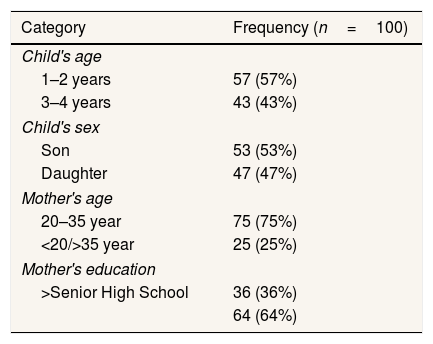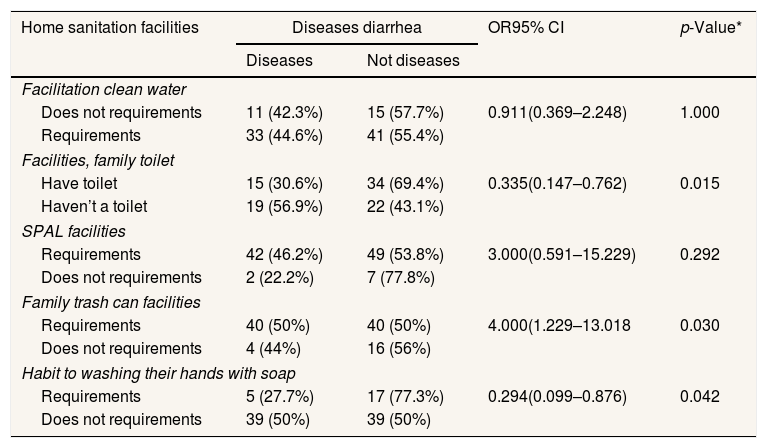
The 3rd International Nursing and Health Sciences Students and Health Care Professionals Conference (INHSP)
More infoThe existence of basic sanitation facilities is still one of the causes of diarrhea disease in East Nusa Tenggara, this study aimed to analyze basic house sanitation facilities and the habit of washing hands with soap on the incidence of diarrhea in children under five.
MethodsThe research this observational analytic study used a cross sectional design. Samples are 100 houses of children under five in Oelnasi Village. The instrument used in this study was a data collection sheet in the form of a checklist and questionnaire.
ResultsThere were only 3 variables related to the incidence of diarrhea diseases with p<0.05, i.e. family toilets facilities (OR 0.335, 95% CI: 0.147–0.762), family trash facilities (OR 4.000, 95% CI: 1.229–13.018), and hand washing with soap facilities (OR 0.294, 95% CI: 0.099–0.876).
ConclusionsSome sanitation facilities that do not meet the requirements can cause diarrhea in children in Oelnasi Village. It is hoped that the community will pay more attention to basic sanitation hygiene they have, get used to washing their hands with soap before feeding toddlers, throwing garbage in its place, and not letting toddlers defecate in any place.
Environmentally based diarrhea disease is still one of the world's health problems, especially in developing countries, including Indonesia.1 The World Health Organization (WHO) states that diarrhea is the second leading cause of death in children under five. One of the causes of diarrhea is the poor condition of basic sanitation facilities owned by the community.2 It is estimated that 2.4 billion people in the world live with inadequate sanitation facilities, where 663 million do not have access to clean water, and 946 million still practice open defecation.3,4 As many as 1.8 million deaths among children are estimated to occur in low and middle income countries (LMICs).5
The incidence of diarrhea in Indonesia is still high, the incidence of diarrhea outbreaks often causes death in various regions. The national prevalence rate for diarrheal disease in 2018 reached 12.3 percent.6 Recent research point for further research to focuses on mortality and morbidity factors, cultural factors, and determining factors of diarrheal disease.7 Recent research reports indicate that the quality of household drinking water and community behavior in good sanitation practices are important mechanisms to protect the risk of diarrhea in children, besides that the habit of washing hands properly can reduce the incidence of diarrhea by 30%.8 Diarrheal disease is an environmentally based disease that is still the biggest health problem in Indonesian society and is a disease that often occurs in children under five. The cause of diarrhea that becomes a problem is poor basic sanitation conditions, such as latrine sanitation, clean water facilities (SAB), sewerage (SPAL), the quality of teriological tubs of water, and house conditions.9
Basic house sanitation focuses on monitoring various environmental factors that can affect human health.7 The purpose of this study was to determine the relationship between household sanitation and the habit of washing hands with soap and the incidence of diarrhea in children under five in Oelnasi Village, Central Kupang District, Kupang Regency.
MethodsThis observational analytical study used Cross Sectional design. As many 100 houses of under five in Oelnasi Village are used as samples in this study. The research was conducted in the area of Kupang Regency, Indonesia using primary data and secondary data, the sample in this study was all toddler homes in Oelnasi Village, Central Kupang Regency, starting with identifying toddlers in Oelnasi Village and assigning them as population then determining the sample size using the slovin formula and then sample, sampling techniques in this study are simple random sampling. the inclusion criteria are one child under five at home, a housewife, or a toddler caregiver as respondents to get information about the research variables. The research variables were Clean Water Facilities, Family Toilet Facilities, SPAL Facilities, Family Trash Can Facilities, Hand Washing Habits with Soap. Questionnaire is used by interviewing mothers/caregivers to collect research data. All variables entered in the final model with a p value <0.05 were considered to be statistically associated with the incidence of diarrhea in children.
ResultAnalysis of respondent characteristicsThe number of respondents was 100 children under five in Oelnasi Village, shows the highest age of toddlers 1–2 years 57%, the highest gender of children under five (61.9%), the highest age of the mother or caregiver of toddlers is 20–35 years (75%), the lowest mother's education high school (64%) with home sanitation characteristics of labor can be seen in Table 1.
Relationship between home sanitation facilities and the occurrence of diarrheaThe results of the statistical analysis of the characteristics of home sanitation with the incidence of diarrhea showed that there were 3 variables of home sanitation facilities that were closely related to the diarrhea incidence in children under five in Oelnasi Village. Significant variables with p values <0.05 i.e. family toilets facilities (OR 0.335, 95% CI: 0.147–0.752), family trash facilities (OR 4.000, 95% CI: 1.229–13.018), and hand washing with soap facilities (OR 0.294, 95% CI: 0.099–0.876), as shown in Table 2.
Relationship between home sanitation facilities and the incidence of diarrhea.
| Home sanitation facilities | Diseases diarrhea | OR95% CI | p-Value* | |
|---|---|---|---|---|
| Diseases | Not diseases | |||
| Facilitation clean water | ||||
| Does not requirements | 11 (42.3%) | 15 (57.7%) | 0.911(0.369–2.248) | 1.000 |
| Requirements | 33 (44.6%) | 41 (55.4%) | ||
| Facilities, family toilet | ||||
| Have toilet | 15 (30.6%) | 34 (69.4%) | 0.335(0.147–0.762) | 0.015 |
| Haven’t a toilet | 19 (56.9%) | 22 (43.1%) | ||
| SPAL facilities | ||||
| Requirements | 42 (46.2%) | 49 (53.8%) | 3.000(0.591–15.229) | 0.292 |
| Does not requirements | 2 (22.2%) | 7 (77.8%) | ||
| Family trash can facilities | ||||
| Requirements | 40 (50%) | 40 (50%) | 4.000(1.229–13.018 | 0.030 |
| Does not requirements | 4 (44%) | 16 (56%) | ||
| Habit to washing their hands with soap | ||||
| Requirements | 5 (27.7%) | 17 (77.3%) | 0.294(0.099–0.876) | 0.042 |
| Does not requirements | 39 (50%) | 39 (50%) | ||
As the main cause of death in children under five, especially in developing countries, diarrhea can actually be prevented.10 The results showed that out of 100 toddlers (42%) had diarrhea and (56%) children under five did not diseases diarrhea, the characteristics of mothers or caregivers of toddlers are mostly aged 20–35 years (75%) with education level p<0.05, this is because the understanding of disease transmission is still very minimal.11
The results of the analysis of home sanitation facilities on the incidence of diarrhea disease in Oelnasi Village, Kupang regency, shows that of the 5 research variables there are 3 variables of home sanitation facilities which show a significant relationship to the incidence of diarrhea significant variables with p<0.05, there were family toilets facilities (OR 0.335, 95% CI: 0.147–0.762), family trash facilities (OR 4.000, 95% CI: 1.229–13.018), and hand washing with soap facilities (OR 0.294, 95% CI: 0.099–0.876). The use of sanitation facilities is very important to the prevention of diarrhea.
The results of research from Lawrence JJ et al. are Sanitation facilities are closely related to the incidence of diarrheal disease in the community, especially in children under 5 years of age.12 it shows that the use of healthy latrines and good hand washing practices are effective in preventing diarrheal disease.12 Variable of family toilets is relevant to open defecation. 30% of families in Desa Olenasi do not have latrines so they make open defecation. It can be contaminate groundwater, can make a breeding place for flies that can contaminated food when consumed by children. The result of Ayalew et al. showed that the diarrhea prevalence was 9.9% in ODF and 36.1% in OD kebeles. This study shows that the presence of latrines, child immunization, lack of water in the household, and solid waste disposal practices have a significant relationship with the incidence of diarrhea in ODF kebeles.13
Variable of family trash can facilities have a significant relationship with the incidence of diarrhea because if the family do not have a trash can and dump garbage out of place or there is no trash can cover, it can be a breeding place for flies that can contaminate food consumed by toddlers so as to create diarrhea. The results of the study in Nigeria showed that the factors causing diarrhea were: poor water handling (OR=2.0, CI=1.2–3.5), clogged drainage (OR=2.1, CI=1.2–3.7), and breeding sites for flies (OR=2.7, CI=1.6–4.7).14
Home sanitation facilities, not requirements may adversely affect the community, especially those with toddlers. There is no significant relationship between clean water facilities with the incidence of diarrhea because they often used clean water facilities and more important than they always consumed cooked drinking water. On average, meet the requirements (74%) as well as the wastewater disposal facilities, there is no significant relationship with the incidence of diarrhea disease is caused by there is no pool of wastewater around the house which can cause disease-carrying vectors to reproduce. The resulting household wastewater is used to water the yard during hot and dry seasons.
Home sanitation facilities needed to be improved and more attention from people of Oelnasi village and the government should support the people and make supervision to increase the number of toilets and give them information to do not throw feces in any place. The result of Shinta Lindayani dkk showed that essential house sanitation required to be moved forward once more since a parcel of things was not qualified (65.3%) such as clean water (48.4%), human excreta (62.1%), family wastewater (69.5%), and family strong squander (84.2%). Essential house sanitation must be progressed once more because as numerous as 65.5% do not meet the prerequisites, such as clean water (48.4%), human squanders transfer (62.1%), family wastewater (69.5%) and family squander (84.2%). The comes about of the chi-square test appeared that there was a relationship between fundamental house sanitation and the frequency of runs in children (p=0.003).15
ConclusionVariables that cause the occurrence of diarrhea in toddlers in Oelnasi Village are the availability of family toilet facilities, the habit of washing hands using soap by the toddler or by the mother, and the habit of disposing of garbage or the condition of the family trash can. Some sanitation facilities that do not meet the requirements can cause diarrhea in children in Oelnasi Village. It is hoped that the community will pay more attention to basic sanitation hygiene they have, get used to washing their hands with soap before feeding toddlers, throwing garbage in its place or used a requirements trash can and they have to prepare family toilets and not letting toddlers defecate in any place.
Conflicts of interestThe authors declare no conflict of interest.
Peer-review under responsibility of the scientific committee of the 3rd International Nursing, Health Science Students & Health Care Professionals Conference. Full-text and the content of it is under responsibility of authors of the article.















